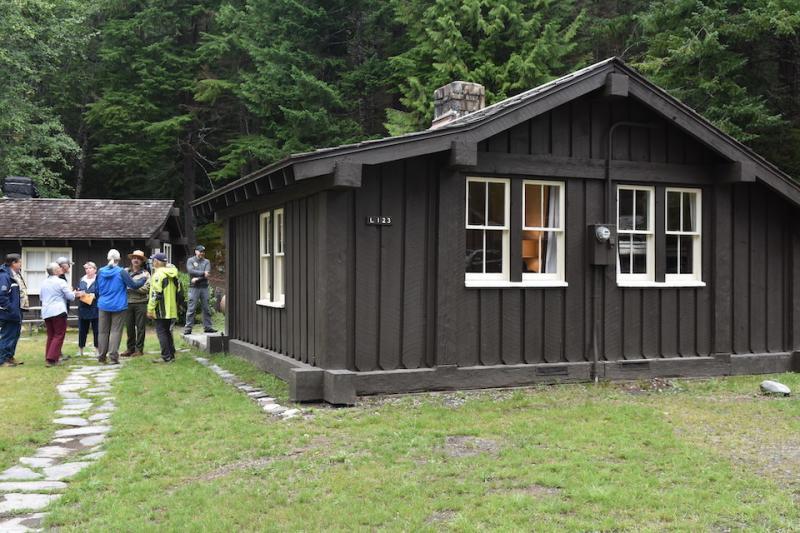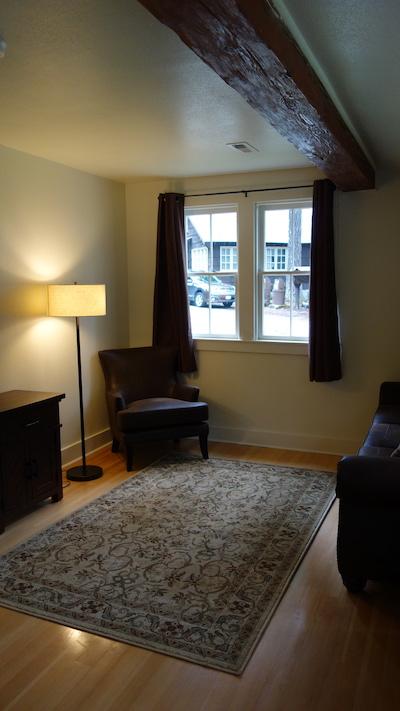
This historic Mount Rainier National Park cabin has been restored for search-and-rescue crew use/NPS
In these types of situations, sometimes there is opportunity, sometimes there is energy, and sometimes there is cooperation. Just one is not enough, but with all three together, it’s amazing what we get done. – Bob Whitehead, Spokane Mountain Rescue
Opportunity – Energy – Cooperation. All are needed to carry out a successful search and rescue. The head of the newest team in Washington State isn’t talking about a mission, but instead about a home for SAR volunteers who come from across the state of Washington to assist in events at Mount Rainier.
Imagine driving for three hours, spending the next six-to-eight hours outside in the snow or rain, then wearily facing the option of either sleeping in your truck or driving your bedraggled body another three hours home. These were the choices that SAR volunteers accepted in their 50+ missions each year at Mount Rainier. If they were lucky, they got to sit down to a meal from the Soup Ladies before heading out. But now the complete renovation of a Civilian Conservation Corps cabin -- dedicated solely for SAR volunteers to strategize, rest, recover and share a meal – has brought them a permanent home.
At the recent ribbon-cutting, a red length of mountaineer webbing was symbolically held by the three partners who made it all happen: Washington’s National Park Fund, the National Park Service, and the Mountain Rescue Association. The newly-restored 1937 CCC cabin had been left mothballed and decaying for the last eight years. Part of government housing in the Longmire Historic District, the cabin is even more special now -- with its new-car smell from bedding and furniture, a fully functional kitchen, and a heralded purpose. For the past four winters, SAR volunteers had been allowed to borrow a seasonal cabin – moving in and out every spring to allow space for the summer seasonal rangers.

The cabin's refurbished interior/Washington's National Park Fund
Rick Lorenz, currently of Tacoma Mountain Rescue, was on hand at the event. “Now we have a formal meeting place to coordinate logistics with rangers and law enforcement. It slides together and works. Everybody wins,” he said.
Rick helped to found the Mountain Rescue Association in 1959. It’s now a national organization, with 300 volunteers and nine teams in Washington State alone.
The cabin project germinated when American Express and the National Trust for Historic Preservation approached Washington’s National Park Fund about a contest to fund a restoration project at Mount Rainier. They challenged the Fund to raise $200,000, and they would provide a matching grant.
“This gem of an idea manifested into being through focused partnerships and resulted in a renovated cabin for SAR volunteers! I can’t wait to peek in someday and see SAR folks resting. It’s what they deserve as they give so much,” articulates Laurie Ward, CEO of Washington’s National Park Fund.
Jared Infanger, Mount Rainier’s historical architect who oversaw all the restoration, noted: “When I started at Mount Rainier five years ago, it was heartbreaking to see this and other CCC cabins rotting into the ground. As stewards of the park, it is our job to maintain the character and stories of these historical buildings.”
Rangers speculate that alumni families – rangers who lived in the 1-bedroom cabins in the '40s with families of 4-6 – will be overjoyed to see the renovations on their next visit. “The construction team are superb craftsmen who take historic buildings and refinish them with modern features," said Infanger. "I’m sure they were cursing me when I had them steaming old lead paint off windows and repurposing the original wood beams with fiberglass rods and epoxy for repair!”
Brett Hergert, the park's operations supervisor who coordinates search and rescues at the mountain, maintains that, “(T)he cabin is a fantastic resource to enable us to coordinate and operate from smoothly. The volunteers can integrate, and it means a lot to me as incident manager.”
The final touches will come soon - from donated local art to buckets of dishware from Goodwill.

Bunk beds stand ready for weary search crews/Washington's National Park Fund
The carpenters even found historic graffiti -- a work's signature on a wallboard -- from 1937 by someone who worked on the roofing with the CCC. That treasure was preserved, and is now buried in the wall, restored for the next generation of SAR volunteers and historical craftsman to discover.
Traveler footnote: To learn more about the cabin and how it was restored, dive into the Traveler's archives.



Add comment